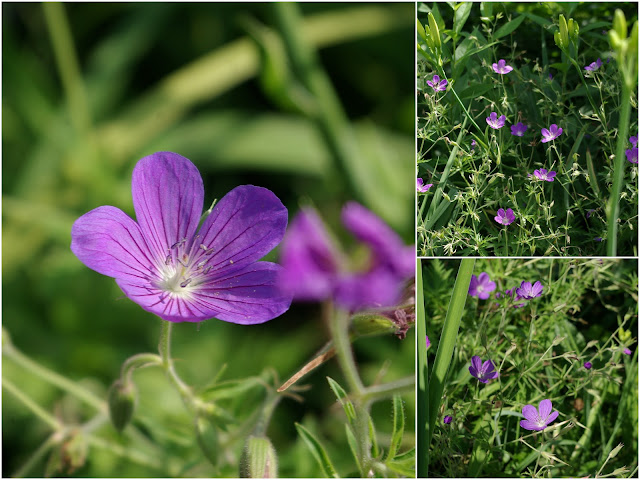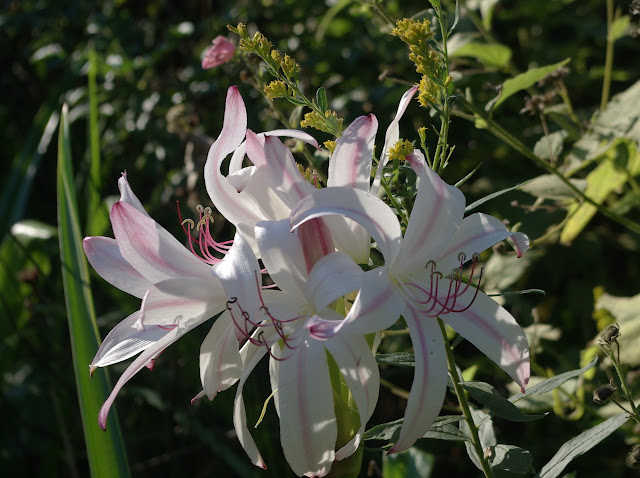The oakleaf hydrangeas in front of the house seem to have been affected by the 12 inches of rain we got last October when tropical storm Matthew came through. They don't like wet roots. I know this because I lost all of my 'Snow Queen' hydrangea after Hurricane Floyd in 1999, when my yard and crawlspace was under at least 18" of water. They didn't die immediately, but by the next spring it was apparent that they were all gone. This time the hydrangea were not in a flood zone and in a raised bed to boot, yet one hydrangea is gone and another two may go as well, as they have shown some signs of wilting. The one that died is one the eastern end and I replaced it with an Alabama azalea.
A few years ago I planted an Alabama azalea after seeing one at the UNC Arboretum, and then it started to decline for unknown reasons. I've been wanting to try one again. They are not only very showy, the flowers have a delicious lemon scent.
If another hydrangea goes I'm not sure what to replace it with. After the first set of hydrangea died I planted Florida azaleas in front of the house and I loved them, but Florida azaleas can get really big, taller than the 8 feet to the top of the porch railing. I'd put a coast azalea there but I'm not sure they would bloom. When I had coast azaleas in front of the house they leaned forward toward the light, and the house faces more directly north than it did originally. I may replace it with Hydrangea paniculata 'Vanilla Stawberry' after seeing it in Rose's garden. In addition, a neighbor has a paniculata that blooms in the deep shade of a mimosa.
The prairie roses (Rosa setigera) beside the driveway keep growing, and growing, and growing. The 2 original plants that I grew from seed obtained in a Gardenweb trade take up about 50 feet along the drive. Then I took hips from those roses and grew some more. This species is fragrance free but gorgeous and the bees love it. I'm taking pictures of the flowers and I blink and there's a bee. The flowers open up bright bright pink and fade to a soft mauvey pink.
Pickerelweed is a native that I planted in the ditch by the old house site. I love the purple
flowers, I love how much it colonizes, and I love that the flowers are a bee magnet.

flowers, I love how much it colonizes, and I love that the flowers are a bee magnet.

Sorrel tree blooms from a row of volunteers next to the drive between the current and old house sites. They don't have the classic Christmas tree shape and flawless crimson color for which they are known, but they still have good red fall color and are lovely trees.
or at least it did before I transplanted them into sunken
pots to protect them from voles. Haven't seen them since. :/

pots to protect them from voles. Haven't seen them since. :/

A purple geranium that I picked up at Powell Nursery in Selma (now closed) several years ago. Unfortunately I do not know its name. Its very vigorous and I've divided it many times and spread it all over the gardens near the house.
Zigzag iris (Iris brevicaulis) is usually the last iris to bloom in my garden. It's an easy to grow woodland native and its profusion of ageratum blue flowers in the heat of early summer are always pleasing to me, and a little surprising too. Its only drawbacks are that the foliage tends to pale to a yellow green when it blooms, and every few years it needs to thinned so it will keep blooming. Thinning is very easy though; all I need to do is pull up crowded fans. There's no need to dig and replant.
Summer phlox 'Robert Poore' by the front sidewalk.
I moved some there since it was struggling next to the house.

I moved some there since it was struggling next to the house.

'Robert Poore' and 'David'. Showy, but I have mixed feelings. It's tall and shaggy and likes to creep
up to the edge of the sidewalk and flop over onto it. I would like to add more diversity in color,

up to the edge of the sidewalk and flop over onto it. I would like to add more diversity in color,

The summer phlox at the Botanical Garden has a beautiful range of colors, ranging from dark shocking pink to rose pink to soft baby pink to white, some with dark eyes.
Last fall I moved 'David's Lavender' out from under the swamp rose next to the vegetable garden but it wasn't ready to bloom this summer. Hopefully it survived the move. I also ordered four new cultivars last fall. They were tiny; I probably should have kept them potted up for the winter and then let them size up the following spring but I went ahead and planted them. I'd be surprised if they made it.
I want to put something shorter than phlox right next to the sidewalk, but it's something that needs to be able to compete with the phlox. I wish that when voles started eating all of my iris that I had planted next to the sidewalk I had thought of putting wire mesh under the rhizomes, but I didn't. That ship may have sailed, now, as the phlox would literally overshadow the iris and iris don't fare well in those conditions. I still miss having iris by he sidewalk.
Quaker Lady with "Eva's White" and probable 'Indian Chief' in
foreground and 'Helen Collingwood' in background, 2008.

foreground and 'Helen Collingwood' in background, 2008.

(I want to bring back blue toadflax too. I haven't seen any around for a while. It's a host plant for the lovely orangetip falcate butterfly. Prairie Moon Nursery hasn't carried any seed for a couple of years so I ordered some off of Amazon.)
I could try to move some of the phlox out, but I'd have to get every bit. I have moved phlox from areas beside the house where it looked hot, dry and miserable, only to have it reappear, multiple times. It's like zombie phlox. Also, as I mentioned earlier, it likes to travel.
On the other hand, I am pleased with the phlox in the big perennial bed without any reservations. It wasn't even phased by the flooding we got below the house after a foot of rain last October, which surprised me. I'd have expected flooding to end it, and viewed phlox as a perennial there until it wasn't. It provides a bright burst of color during the summer months that is visible from the house. I have to put up a couple of motion detection sprinklers to keep the deer from eating it.
More phlox may end up down there if I can't keep my baptisia going, but that's a subject for another post!











































